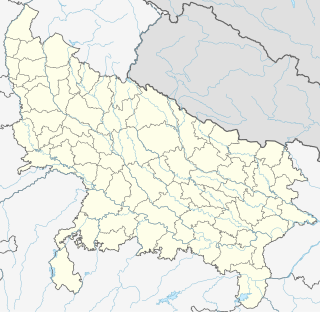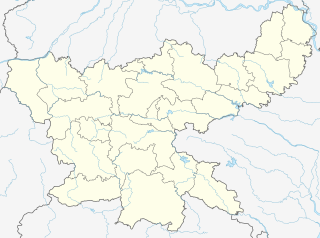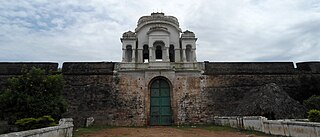 W
WBaliati Zamindar Bari is located at the village of Baliati, in Saturia Upazila in Manikganj District, Bangladesh. It is the palace of the Zamindars, the Baliati Zamindari who ruled over a large area. The Baliati Jamindar Bari is located at 23.9952°N 90.0419°E.
 W
WBanaili was a zamindari estate based in the Indian state of Bihar. They were considered one of the ruling dynasties of the Mithila region. All the rulers and holders of this estate were Maithil Brahmins.
 W
WBarauli Rao is a town, panchayat block and Vidhansabha constituency in Aligarh district in the Indian state of Uttar Pradesh.
 W
WThe Bardhaman Raj, also known as Burdwan Raj, was a zamindari estate that flourished from about 1657 to 1955 in the Indian state of West Bengal. Maharaja Sangam Rai Kapoor, a Khatri from Kotli, Punjab, who was the first member of the family to settle in Bardhaman, was the original founder of the house of Bardhaman, whereas his grandson Abu Rai, during whose time the zamindari started flourishing, is considered to be the patriarch of the Bardhaman Raj family.
 W
WBhadri was an estate (taluqdari) of Oudh, British India. Now it is part of Pratapgarh district in Uttar Pradesh, India.
 W
WBhawal Estate was one of the largest zamindari estate in Bengal in modern-day Bangladesh. It had 2,274 villages in an area of 1,500 kilometers and a population of 55,000.
 W
W{{Infobox settlement | name = Chhatari | native_name = | native_name_lang = | other_name = | nickname = | settlement_type = Town | image_skyline = Chhatari_Fort.JPG | image_alt = | image_caption = The inside gate of Chhatari Garhi | pushpin_map = India Uttar Pradesh | pushpin_label_position = | pushpin_map_alt = | pushpin_map_caption = Location in Uttar Pradesh, India | coordinates = 28°06′44″N 78°09′09″E | subdivision_type = Country | subdivision_name = India | subdivision_type1 = State | subdivision_name1 = Uttar Pradesh | subdivision_type2 = District | subdivision_name2 = Bulandshahr | established_title = | established_date = | founder = | named_for = | government_type = | governing_body = | unit_pref = Metric | area_footnotes = | area_rank = | area_total_km2 = | elevation_footnotes = | elevation_m = | population_total = 15786 | population_as_of = 2019 | population_rank = | population_density_km2 = auto | population_demonym = | population_footnotes = | demographics_type1 = Languages | demographics1_title1 = Official | demographics1_info1 = Hindi, [[Urdu],[English]] | timezone1 = IST | utc_offset1 = +5:30 | postal_code_type = | postal_code = 203397 | registration_plate = UP-13 | website = | footnotes = }} Chhatari is a Town in Bulandshahr district in the state of Uttar Pradesh, India.
 W
WDighapatia Raj was a zamindari in present-day Rajshahi, which was ruled by this dynasty of 7 generations of Rajas from early 18th century till the mid-20th century; when the democratic government took power after the end of the British Monarchy's rule in India, in 1950, the East Pakistan government abolished aristocracies and the zamindari system in present-day Bangladesh. The family was seated at the Dighapatia Palace.
 W
WEttayapuram is a panchayat town in Thoothukudi district of Tamil Nadu, India. It is the birthplace of Tamil poets Mahakavi Bharathiar and Umaru Pulavar. Muthuswami Dikshitar, one of the triad of Carnatic music was patronized in his final years by the ruler of Ettayapuram.
 W
WGhughudanga Zamindar Bari was the residential palace and place of business of the Ghughu-danga zamindar family. It is situated on the banks of the Purnobhoba River in Dinajpur District. The palace was destroyed by Pakistani soldiers in the 1971 Bangladesh Liberation War.
 W
WGuha Thakurta or Guhathakurta is a British Raj era Zamindar family from Bengal Presidency.
 W
WHaripur Barabari, is a palace in Horipur Union of Nasirnagar Upazila at Brahmanbaria district, Bangladesh earlier known as East Bengal. This palace founded by Jamindar Krishna Prasad Roy Choudhury(1870-1936) in eighteenth century.
 W
WThe Jagdishpur estate was a zamindari estate situated in modern-day Bihar, India in erstwhile Shahabad district. The centre of the estate was the town of Jagdispur however the estate also covered neighbouring towns and villages. The estate was also protected by a fort.
 W
WJhargram Raj was a zamindari which occupied a position in Bengal region of British India. The zamindari came into being during the later part of the 16th century when Man Singh of Amer was the Dewan/Subahdar of Bengal (1594–1606). Their territory was centered around present-day Jhargram district. Jhargram was never an independent territory since the chiefs of the family held it basically as the zamindars of the British Raj in India after Lord Cornwallis's Permanent Settlement of 1793. Although its owners were both rich and powerful, with the chiefs of the family holding the title of Raja, the Jhargram estate was not defined as a Princely State with freedom to decide its future course of action at the time of Indian independence in 1947. Later, the Vice-Roy of India agreed to recognize Jhargram as "Princely State" after the Second World War, but the proposal taken back as the British had decided to give independence to India.
 W
WThe Zamindars of Kanihati, also known as the Chaudhury family of Kanihati, are a notable zamindar family of the Sylhet region. The family was started with the marriage of a Tripuri princess with Abd al-Malik, the son of Shah Halim ad-Din Narnauli - an Arab Sufi saint and companion of Shah Jalal. The title of Chowdhury was used by the family after it was granted to Nasir ad-Din by the Mughal Empire.
 W
WLedo is a village located in Giridih district in the Indian state of Jharkhand.
 W
WMaurha is a village and a Gram panchayat in Ballia district in the Indian state of Uttar Pradesh. Its population is 555, per the 2011 Census. Maurha's nearest railway station is Belthara Road. During British India it was a Taluqdari
 W
WNadia Raj were a dynasty of Zamindars and the rulers of territories that are now part of the Nadia district region of West Bengal, India. Their seat was at the city of Krishnanagar, Nadia. The estate of Nadia Raj was estimated to cover an area of 8,161 square kilometres (3,151 sq mi).
 W
WNuzvid Zamindari is one of the ancient Zamindari of the Madras Presidency. It comprises nearly about 288 villages or 18 paraganas. It pays a peskash of 95,443/-.It is further divided into Vuyyuru, Mirzapuram, Kapileswarapuram and other estates.
 W
WPahasu is a town and a nagar panchayat in Bulandshahr district in the Indian state of Uttar Pradesh.
 W
WPanchkot Raj, also known as Panchkot Zamindari or Kashipur Raj, was a family of kurmi Zamindars who ruled in the western fringe areas of present-day West Bengal, India and some of the adjacent areas in present-day Jharkhand.
 W
WPithapuram Zamindari was one of the largest and wealthiest Zamindari in the East Godavari district, Madras Presidency. In 1802, Pithapuram was overshadowed by the renowned Peddapuram estate. But, in 1843, all other villages of Peddapuram were lost except Kottam and left with only 36 villages. Pithapuram rise to power and also bought many other estates of Peddapuram, Thotapalle Estate, etc. By 1874-1875 this estate had a revenue of INR 5,51,231 and paid a peskash of 2,50,160/-.
 W
WThe Prithimpassa family, also known as the Nawabs of Longla, are an aristocratic family from the Prithimpassa Union, Kulaura Upazila, Moulvibazar, Sylhet, Bangladesh. The family was of the erstwhile feudal nobility of East Bengal. They played important roles in the Indian Rebellion of 1857, the Partition of India and Sylhet referendum in 1947, and the Bangladesh Liberation War of 1971.
 W
WThe Puthia Raj family was created by the Mughals in the early seventeenth century and is one of the oldest feudal estates of Bengal. A lord named Nilambar received the title of Raja (King) from the Emperor Jahangir. In 1744, the region was divided between King Nilambar's sons and the Puthia Raj family was born. The family built lavish palaces and temples, such as the Puthia Temple Complex, and were noted philanthropists. Later the Puthia Raj estate was maintained by Lahiris until the abolition of the zamindari system under the newly formed democratic Government of East Pakistan after passing of the East Bengal State Acquisition and Tenancy Act of 1950, just two years after the fall of the British Raj. The palaces are currently administered by the Government of Bangladesh.
 W
WDarbhanga Raj, also known as Raj Darbhanga and the Khandwala dynasty, was a Maithil Brahmin dynasty and the rulers of territories, not all contiguous, that were part of the Mithila region, now divided between India and Nepal.
 W
WTekari Raj was a zamindari estate belonging to a family of the Bhumihar community in South Bihar. They controlled 2,046 villages on their estate, which covered a 7,500 square kilometres (2,900 sq mi) area, near to the town of Gaya.
 W
WRajshahi Raj was a large zamindari which occupied a vast position of Bengal. It was the second largest zamindari with an area of about 33,670 km2, after the Burdwan Raj. The zamindari came into being during the early part of the 18th century when Nawab Murshid Quli Khan was the Dewan/Subahdar of Bengal (1704–1727).
 W
WThe Ramnad estate was a permanently settled zamindari estate that existed in the Ramnad subdivision of the Madurai district and later Ramnad district of the erstwhile Madras Presidency in British India from 1601 to 1949. It was ruled by the rajas of Maravar caste who also had the title of Sethupathi. Maravars ruled the Ramnad area as traditional chieftains between 14th to 16th century CE, and in 17th century CE they expanded their power to establish "Ramnad Kingdom" which is also known as "Maravar Kingdom", in 1795 CE after the Carnatic wars they were reduced to the status of zamidari by the British raj. After the independence of India in 1947 the estates were merged in the Union of India and in 1949 all rulers lost the ruling rights, privy purse was also finally abolished in 1971.
 W
WSadabad is a town and a nagar panchayat in Hathras district in the Indian state of Uttar Pradesh.
 W
WSonbarsa in Saharsa district, Bihar, India is a main settlement on National Highway 107, extending from Maheshkhunt to Purnia. Sonbarsa is a Town in Sonbarsa Tehsil, Saharsa District, Bihar State. Sonbarsa is located 24.1 km distance from its District Main City Saharsa. It is located 210 km distance from its State Main City Patna.
 W
WChoudhary Kedarnath Thakur was the Zamindar of Singhwara Estate. The estate situated in the Darbhanga district of Mithila in Bihar. He belonged to the Zamindar Family of Mithila (region). He held his title over his family estates in the Singhwara when such titles were abolished following the Independence of India.
 W
WUthumalai, also known as Uttumalai, is a village in the Indian state of Tamil Nadu. It lies in Veerakeralampudur taluk, which itself is in Tenkasi district.
 W
WVegayammapeta Estate is an ancient zamindari estate which is permanently settled by the British Government in 1802–03 with a revenue of 17,196 and a peskash 8,464. It comprises 10 villages.
 W
WVizianagaram State was one of the most important zamindaris of the Madras Presidency in India. The estate acceded to the Indian Union in 1949.
 W
WThe Zamindars of Bihar were the autonomous and semi-autonomous rulers and administrators of the Mughal subah of Bihar and later during British rule. The zamindars of Bihar were numerous and could be divided into small, medium and large depending on how much land they controlled. Within Bihar, the zamindars had both economic and military power. Each zamindari would have their own standing army which was typically composed of their own clansmen.